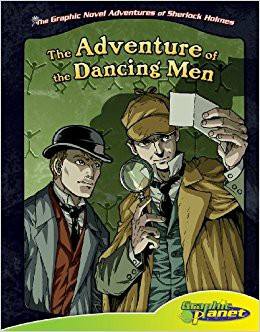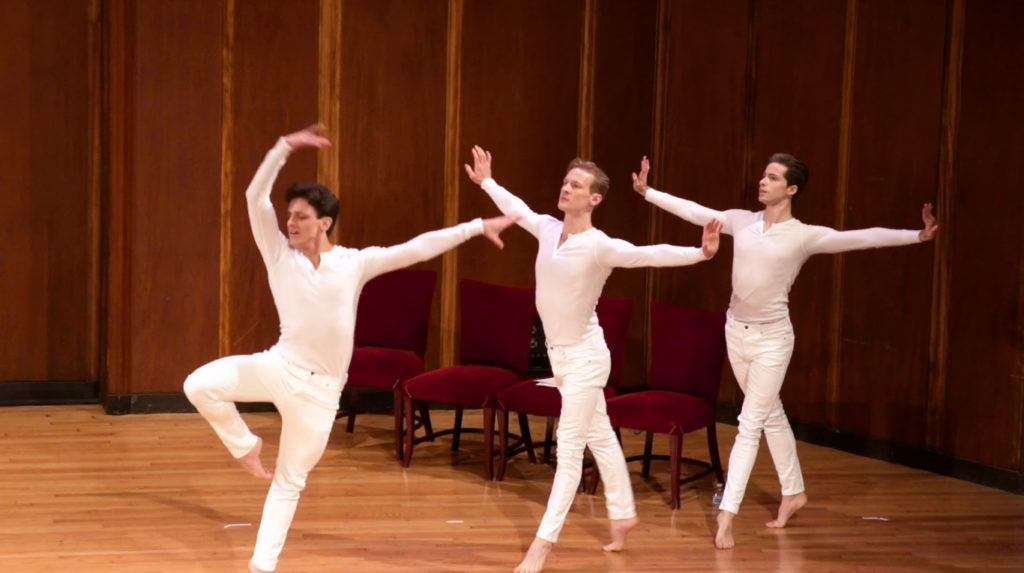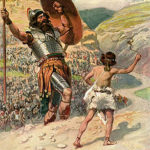Weirdness In Church? Or: The Adventure Of The Dancing Men
What hath male ballet dancing in church to do with Christians enjoying fantasy stories?
Answer: Both ballet dancing and fantasy fandoms are seen as weird, and misunderstood. Christians can slander both of these as if they’re automatically sinful. Yet both can be ways to glorify God—though not necessarily in a local church service.
So who actually did ballet dancing in church? Last November, Redeemer Presbyterian Church did, at one of its locations in New York City. Its video from last November is simply titled “Life Together.” It features three male ballet dancers clad in white (thank God they don’t have those tights) who portray a three-part, interwoven relationship.
But without further explanation, you can’t tell for certain what the performance is about.
One biblical pastor, who posted the video nearly eight months later, said that its theme confused him. Then he said he read this excerpt from the church’s pastor, Tim Keller:
If God was unipersonal, there would have been no love until he created the world. However, if the world was created by a triune God, then relationships of love are what life is all about. The Godhead is characterized by mutual self-giving love as the Father, Son, and Holy Spirit orbit around one another in a dance. It is impossible for us to join in if we focus on ourselves, but through Jesus Christ and his sacrificial death on the cross, we can be brought into the dance.
 So far, I haven’t found if the performers meant to portray the Trinity’s relationship of harmony. (If they only meant to portray something more human, such as members of the Church working together, it’s interesting that viewers compared this to the Trinity!)
So far, I haven’t found if the performers meant to portray the Trinity’s relationship of harmony. (If they only meant to portray something more human, such as members of the Church working together, it’s interesting that viewers compared this to the Trinity!)
It’s easier to see that people thought the performance was really, really “gay.”
A few of the comments:
Is the Trinity gay?
I always thought Tim Keller was effeminate. No respect for him at all.
Too effeminate….men shouldn’t be moving and dancing like this…it’s gross…
Add this to the dung Hill of heresy that attempts to feminize God.
There are dance moves that are masculine and feminine. And clearly, this entire dance routine was feminine.
Then one Christian leader got into the “effeminate” accusation. He claimed the performance was “gayer than the kiwi queen of the fire island fruit festival.” (I don’t even know what this means, though it must have felt really awesome to put that phrase on the screen.)
All this is nonsense.

Totally “gay.”
You can’t call men dancing, with classical ballet moves, and even touching or lifting each other (this is part of ballet!), “gay.” Or “effeminate.” Such a slander is not based in biblical discernment. The point is worth a quick exploration before we move on.
Nothing in Scripture supports any kind of “everyone knows” definition, of which speech patterns, colors, gestures, or interests count as “masculine” or “feminine”—meaning that if a man likes or does “women’s” things, he counts as sinfully “effeminate.” There is no single, advanced culture that “fixes” biblical masculinity as denoted by muscular bodies, trucks, tools, sports, blue instead of pink, nonfiction over drama, or no-dancing over dancing.1
As one commentator rightly noted:
I’ve been all over the world and grew up in different cultures. And, yes, I have seen plenty of male/male kissing and hand-holding and dancing that would be considered effeminate by men here. I’m quite familiar with the American fundamentalists’ conception that anything uncomfortable to them is necessarily an abomination. … I get weary of any kind of less-than-American-cowboy machismo being decried as effeminate, as if that is what the biblical conception of effeminate actually meant.
Indeed, this is a very modern, Western notion. It skews what Paul meant by “effeminate” in 1 Cor. 6:9 (NASB). Other translations combine this word into the phrase “men who practice homosexuality (1 Cor. 6:9, ESV). Instead, this judgment of what counts as “effeminate actions” is based in cultural assumptions, and very, very strong feelings. This may include some strong feelings of men, who may feel personally threatened by other men who do not act or behave in “traditional” masculine ways, or share “traditional” male interests.
No, Christians can’t discount those feelings. We can’t just say, “No, that’s just your feelings talking. So shut up and let them do their thing.” Instead, let’s keep talking! Ask, “How did you feel about that?” Or, “What did that thing they did mean to you personally?” Or even, “Yes, there are people intentionally trying to blur the differences between sexes. This is absolutely wrong. But do you think ballet has been, or can be, only done to do this?”

How I often feel watching ballet. (From Arrival, 2016.)
But we must see that the discussion is based on strong feelings either way. It is not a matter of “firm biblical conviction against the thing, versus worldly compromiser for the thing.”
For my part, I don’t get ballet. It’s an alien language to me. Watching it feels like repeated attempts to make first contact with an alien civilization. I don’t get why we “need” ballet. I don’t get why people would need to dance out their emotions. After all, we have perfectly great words, images, and even music to reflect those feelings?
Yet these are just my feelings. They are my preferences. Other people watch and perform dances, including ballet, and they are strongly moved.

Worst of both worlds: the “effeminate” wizard Howl from Howl’s Moving Castle (2006).
But I do know fantasy fiction.
I know why we need it and why God has used it so powerfully in my life to glorify Himself.
And I know that many other people don’t understand this. They may even think fantasy suspicious, or sinful. Or else they justify some fantasy, such as A Christmas Carol, but dislike other fantasy for subjective reasons (e.g., “that picture of that one creature creeps me out”).
They’re wrong, of course. But we can work with that, based in love. God does command His people to work with these issues in love (Romans 14, 1 Cor. 8-10, Gal. 5:13). If you feel a thing is sinful for you to do, don’t do it. If you feel a thing is not sinful for you, but you also know someone who knows you do it is tempted to sin, then in love, avoid that thing.2
However, the question remains: could ballet performances be included in a church service?
My strong inclination is to say no. I don’t say this because I personally don’t get ballet. It’s because I can compare this to my enjoyment instead. Then I can ask, “What would I think of someone reading a great fantasy novel excerpt in church?” That wouldn’t seem right. It would distract from the central purpose of the local church service: to teach and sing about Jesus’s gospel teaching among the people of God in fellowship.3
Dancing can glorify God. It can even do this with behaviors certain Christians would call “effeminate” (because it makes them feel weird). Fantasy novels can also glorify God. But at least for now, let’s not try to force either thing into local church services. Anyway, whoever said you can’t really, super-glorify God with a thing unless you do it on Sunday mornings?
- In fact, as several friends of mine pointed out, many men practice overt masculine “trappings” that Christians would not find “effeminate,” and yet also sinfully practice homosexuality. ↩
- Note that the apostle Paul always assumes actual, present scenarios when Christians try to keep other Christians from stumbling. Sometimes people turn this into “try to head off any hypothetical stumble situations, ever.” But that is a legalistic application of the text. It’s also absurd: you can’t head off every potential stumble situation in the universe. ↩
- For those of you who do doctrine by names, I haven’t been entirely sold on the “regulative principle of worship.” This is the idea that church worship services ought only to include elements that the New Testament mentions occurring in these services. I haven’t been sold on it, mainly because it seems to fail its own test. But you’re welcome to persuade me in the comments! Anyway, I’ve seen little error come from this concept. Whereas we see many errors when people disregard this concept and decide that the “church service” can include anything. (Even from a creative view, making any “genre” include anything weakens its distinction.) If we do that, church service quits serving its own unique purpose: to train God’s people in the gospel. If the “regulative principle of worship” focuses on this training aspect, rather than portraying the fixed-form church worship service as a means to itself, I can get behind it. This doesn’t mean that dancing or novel-reading can’t ever be done in a church building. ↩











































I guess I disagree. A couple weeks ago we used clips from Thor to teach the gospel during church service. We’ve also used Darth Vader as examples of anger, Barbie and Ken to talk about the plastic masks we put on as Christians to hide from others, and one could even use Gollum as the dual nature of how we want to do right, but also want to do wrong. In church service.
I think sometimes we as Christians—living in our Christian bubble-world—forget what it’s like to enter a church. A couple weeks ago I took a tour of historical churches around my town and even I felt uncomfortable, like I had entered some portal to a completely foreign world I knew nothing of.
That is why we use secular things in our church service, to create a bridge for those coming for the first time. And to use everyday images and stories people already know about to help them understand biblical truths. I call these “handles”. It is one thing to expound on grace, it is another to take that kind of heady knowledge and find a way for people to grab onto it.
I also think keeping secular things outside of church service in some ways perpetrates the idea of dividing our lives into sacred and secular. At church, we only talk about and do churchy stuff, but at home, I can talk and read stuff that’s secular. Instead, shouldn’t we show how everything has the possibility of teaching us about God? This past week I watched a show my son has been wanting to watch and we had some great conversations. Why can’t those conversations happen in a church service?
So yes, I think we can read an excerpt from a fantasy novel on a Sunday morning and use it to teach about Jesus’s gospel teaching among the people of God in fellowship.
My wife similarly noted that the long-practiced sermon illustration, which compares the teaching to daily life — a tradition that every pastor follows to some extent — could also support this. Jesus Himself did this. In fact, you almost need to do this sometimes, lest you reinforce a sacred/secular dichotomy. But in that case, the “secular” thing flows naturally from the traditional elements of the service order: teaching, singing, fellowship and so on.
Exactly. And I believe that secular elements can be used within the service order, including fantasy fiction. After all, Jesus taught in a similar fashion, using stories and symbols the people were already familiar with and using it to teach them about God.
But what Biblical truth was that dance teaching?
The beauty of relationship.
Men with men? Did that dance foster a desire for more fellowship among believing men? I suppose that may have been the choreographer’s intent. But I think that’s debatable.
Is it such a bad thing to feel like you are entering a foreign place when you walk into church? Because the reality is that is what is happening. The gathered church is an embassy of the kingdom of God, a new world with a very different culture from the world we live in. One of the reasons I left contemporary evangelicalism (and joined a conservative Episcopal Church) is because I wanted to worship in a way that was different from the way the culture worships.
This is, perhaps, also the appeal that fantasy literature presents. Often these stories involve the discovery of a new and alien world and way of life that is really there, yet hidden from the surrounding culture. I’m thinking of Harry Potter, which does this very well, but it’s a common element of fantasy stories.
If it keeps people from walking into a church, then I think it is a hinderance to the very thing we are supposed to be doing: reaching the lost. We live in a post-Christian world, one that is so far from removed from God that the only reason they know the word “Jesus” is as a cuss word and that Christians are homophobic bigots. The church building is not about making Christians comfortable, it is about being a meeting place where our community knows we gather and anyone can come, and the building exudes that feeling of welcome, not exclusivity.
I agree in the sense that the church building and mode of worship is not really about making anyone comfortable, least of all the congregation. It’s about calling all of us to enter into the life of Christ, which is different from the way we are naturally inclined to live.
Exactly!
But aren’t we to go into the world and preach the gospel? Where did we get this idea that bringing unsaved people to church is the way to go? Church is for edification of the body, isn’t it?
Becky
A little late, but well said Becky.
I agree that we can use fantasy novels, movies, and other familiar pop culture references in conversation to help non-Christians understand concepts about the gospel and the church that would otherwise be hard for them to grasp. In fact, when talking to a non-Christian friend who had never been able to understand why people would go to church, I once compared church meetings to fandom conventions and you could practically see the light bulb come on above her head.
That being said, though, I can’t see anywhere in the New Testament that supports the idea of adapting our church meetings to make them comfortable, inviting, or even comprehensible to non-believers. The purpose of the church is to equip the saints for the work of the ministry — including the ministry of going out into the world to share the Good News about Jesus Christ and make disciples as He commanded us. If we put the focus of our gatherings on encouraging unbelievers to gather along with us, and adapt our worship and prayer and teaching to suit their thinking, then we’re at serious risk of neglecting the church’s real mandate and stunting its growth. We end up with gatherings full of people who are there for the wrong reasons (“I enjoy the music,” or “The pastor talks about all my favorite superhero movies,” or “That ballet dance last Sunday was beautiful”), while the believers remain immature, unable to move beyond the “milk” of the basic gospel message to the “meat” of sound doctrine and mature Christian living.
I’m not saying we should never use pop culture references as sermon analogies or quote fantasy novels from the pulpit, if those things truly fit the subject at hand and help to make certain points more clear. But I start to get concerned when that becomes the norm, or when pop culture references start taking the place of deeper analogies that come from within Scripture itself. In one-on-one conversations or “seeker studies” in a home it may be useful to do that kind of thing from time to time, because we’re talking to unbelievers with no Biblical frame of reference, or young believers who are still struggling to get a grasp on the basics. But if I walk into a church and see film clips, pop song lyrics and dance routines every week, I’m going to wonder if that particular church has forgotten their real mandate.
^ This. All of this. Amen.
I’m afraid this is where we will have to agree to disagree. I was part of a conservative church a long time ago and actually argued with the same points you have brought up, that church service is really only for Christians, and Sunday morning is only for the mature Christian, to dive deeply into doctrine and theology. Since then, through twenty years of ministry, 15 of them deep inside the church, I’ve come to realize there are steps within discipleship.
Sunday morning church service is not the final discipleship step for a Christian. If that is where they are getting their “meat”, then they will never have patience and understanding for the non-christian who walks in and then walks out because they had no idea what was going on, or for the baby Christian who is still learning their first steps. In our church, Sunday morning church service is geared to share the gospel with the non-Christian and to share biblical truth with everyone, no matter where they are in their walk. Then we have small groups and Bible studies where Christians meet in homes to have closer fellowship, accountability, and dive deeper into the Bible.
It’s not for everyone, and we’ve had mature Christians leave because they weren’t getting “meat” on Sunday mornings. I understand that. No two churches are alike. Jesus called us to go out and make disciples. Disciples first start as unbelievers, then they explore what it means to be a disciple, then they start to learn what it means to follow Christ, then their lives change as they follow Christ, then they start to use the gifts God gave them, then they become mature enough to start passing on what they first learned. It’s a ladder, and you can’t have the first few rungs missing, or you never have new disciples.
I also I’m not sure about the whole “gospel is milk” thing. When we start to think like that, then eventually we move on from the gospel, to those doctrines and theology we think are more superior to the gospel. When in fact, the gospel is not something we move on from, it is something we move deeper into. The moment we move on from the gospel is the moment we move on from grace. I wrote an article about this very thing here: https://morganlbusse.com/2016/02/05/the-gospel-isnt-just-for-non-christians/
The gospel is huge, enormous, deep and complex. It includes some very sophisticated doctrines that we could spend a lifetime meditating upon. But when I say “the basic gospel message”, I’m talking about the very simple truths that we are all sinners, we all need to be saved, and that Christ is the only way. Sure, we could unpack those and draw all kinds of richer truths out of them. But in my experience listening on a Sunday morning to many, many “gospel” messages, that seldom if ever happens. The messages are addressed to the hypothetical seeking unbeliever who has wandered into the building (or more likely, has been invited to “come to church” by one of the believers), and possibly to a few lifelong attendees who grew up “in a Christian family” and somehow might still be clinging to that affiliation and their own good works to make them right with God.
Is that message of “You need to be saved / here’s how” important? Yes. Should it be shared widely and often? Yes. Is the meeting of the gathered church, one of the very few opportunities to have a large group of believers together to carry out the fundamental activities of the church given in Acts 2:42 and elsewhere, an appropriate time and place to preach that message on a regular basis, at the expense of exhorting and equipping the believers to become mature? No. Jesus said to His disciples that they were to go into all the world and preach the gospel, not invite the world to come and meet with them so a trained and polished speaker could tell them the Good News at the disciples’ convenience.
Scripturally speaking, we don’t “do” church or “go to” church or “have a” church, so we can’t invite anyone into the church. Believers in Christ ARE the church, wherever they are and whenever they meet together to worship and learn about Him. And Christ is our Head, no one else. If we’re letting the needs and desires of unbelievers (even what potentially good needs and desires, such as the need for salvation and the desire to learn more about God) influence what we do in our gatherings and steal attention away from the need to nurture and disciple newer believers to maturity, we’re in trouble.
If your local congregation offers regular, easily accessible meetings where deeper teaching and truth is being given and believers are encouraged to grow and challenged to be more obedient to Christ, that’s excellent and I’m glad to hear it. But I still believe that the home, the workplace, the marketplace, and the world in general is the place to preach the “you need to be saved / here’s how” message, and that the meetings of the church are meant for and consist of those who are already believers. An evangelistic outreach program may take place in the same building used by the local church, but it is not a “church service” nor should it take the place of one.
So well said, RJ. Amen and amen!!
Becky
It’s funny – when ballet was first invented, it was an all-male artform. Now people think of it as feminine. Sometimes I think it would be interesting to go through the song of songs and list the metaphors used for the man and the women. Much more overlap than would be the norm in our culture!
Though I do wonder if performance of any kind (including a choir piece or a solo) really makes sense in a church service (as opposed to a Christian concert)?
I agree about performance in church, Kristy. As I see it, even with the “special music” pieces of long ago, the focus was more on the performance and the performer than God who gave the ability. And yet we are gathered to give Him praise, are we not? To give Him praise and to edify one another.
Becky
Saying that, I happily have my Sunday School kids performing a song at the prizegiving, or nativity. But maybe that’s a bit different – it’s kind of half way between a service and a concert.
One thing I like about my church is that most of the band is down on the floor, not on the platform, as if it was a concert.
People in the congregationdancing as part of the corporate worship is a different thing entirely (not that I do it myself, but if that’s the kind of thing that you’re into)
If “performance” is defined as anything done in front of the congregation rather than by the congregation as a whole then, technically, the sermon (the hallmark of most church services) is a performance.
Choir pieces and solos and the dance linked to above and sermons in the church service aren’t primarily intended to entertain but to edify, this I think is the question to ask about anything you want to include in a church service.
Interesting discussion. I guess I’m on the fence on this one. Dance is an art form, and it holds all the “dangers” of art – it’s open to interpretation, and not literal, and people could read in all sorts of things into it and so perhaps could lead people astray. It requires some work on our part to “understand” it, and some contemplation. Which many don’t like. But it’s also something that can deeply move people and help them to see truth in a way that they might not see it through words. I thought this particular dance beautiful, and invited me to think about how we as a church can support and encourage one another. There is some context needed sometimes for art – many times you see contemporary art (i.e. paintings, sculptures, etc) and don’t really understand it until you read the title the artist has given to it. Sometimes the title confuses you more, but it invites more thought about how the title fits. Art takes time to understand, and it is often that conversation between the work of art and the viewer that many don’t want to have, or haven’t been encouraged to explore. In this case, if you had just seen the dance outside of the church and without the title you might think it a beautiful dance (or “gay” if that is where your mind goes) but with the title, and in that context, I find it gives me a starting point for how I see “Life Together” or even how “Life Together” should be. You could have a sermon about how we as church members should be supporting one another and loving each other even through hard times and differences and some might tune out, but compliment it with a dance such as this titled “Life Together” and it might speak to a place in those people who tuned out of the sermon. Why can’t we embrace all of art in our services? Carefully, and prayerfully? Beautiful paintings and sculptures? Dances? Not only for the glory of God, but as tools that God can use to teach and encourage?
I like to think that if postmodern art is experiential, then an experience of bafflement and confusion is also legit.
I also think life is too short to pay much attention to insecure dudes whose masculinities are too fragile to handle seeing a dude do a plie. Gender as performance, indeed.
I have strong feelings about performance, particularly live performance, as part of a worship service. I mentioned that in an earlier reply to a comment. What I don’t see anyone addressing is this statement, Stephen: ‘Nothing in Scripture supports any kind of “everyone knows” definition, of which speech patterns, colors, gestures, or interests count as “masculine” or “feminine”—meaning that if a man likes or does “women’s” things, he counts as sinfully “effeminate.” ‘
I think there’s an implicit understanding that “everyone knows” when we use words. They do have meaning. Paul used the word we translate as effeminate in 1 Cor. 6:9. The Greek meaning relates to homosexuality, but then there’s this part of the definition: “of a male who submits his body to unnatural lewdness.”
The question is, not whether the men in the dance were known homosexuals, but whether they promote gender confusion. I’d say they don’t enhance ideas of masculinity. And that’s based on an understanding of the words masculine and effeminate. No, there isn’t some sort of list: muscles, toe pointing, and so forth. But I’ve seen my share of ballet dances, and there are male roles and there are female roles. Which were these dancers performing?
If someone says, neither, they were portraying God as triune, then I think that’s a problem, too. Are we OK with creating images of God now, in church? As if we could ever portray the transcendent triune quality of God. We can talk about it, give illustrations for it, but we won’t ever be able to portray it. So what did this dance do?
As I saw it, I didn’t think it was sexual. I thought it was rather neuter. And in our culture, which is more and more like that of Corinth, the last thing we should want to do in church is to add to gender confusion. These were men who didn’t move like men. I’ve been to four continents and numbers of countries, and this movement in the dance didn’t come across like typical movement I’ve see from men, here or in other places. Did that make it gay or effeminate? I’d say it was absent of masculinity. And that to me is moving the needle away from where we as a Church should go.
Becky
It’s important to note that the Holy Spirit is sometimes referred to in the feminine voice throughout Scripture, and in Genesis is portrayed symbolically as a sort of “Mother” archetype, while God the Creator and Judge is portrayed as “Father,” and Jesus is the son of God (and the second Adam). The trinity illustrates, symbolically, a full family (the Church being the bride). Scripture even says, “That is why a man leaves his father and mother and is united to his wife, and they become one flesh,” directly after Eve is offered to Adam. If Adam had a “mother,” it was the Holy Spirit. There is masculinity and femininity portrayed in the Triune God, and this is a point the dance could possibly be designed to get us thinking about. Also, women were made to reflect elements of God’s person, same as men, and both women and men more directly reflect different elements of God’s person. This isn’t gender confusion. It’s biblical rock-solid truth.
Brennan, I agree with everything you’ve said here except the conclusion. I’d summarize your point this way: Since God manifests as both male and female, then it’s OK to be gender neutral. Because that’s how those dancers presented.
Of course, nothing about the dance identifies it as the Trinity other than what people said when they commented. But you have given further illustration about the impossibility of us portraying the Transcendence which is God. We aren’t supposed to do it and we can’t pull it off when we try. So that leaves us with three men moving on stage in ways that most men don’t move. In a culture that is charged with gender-identity issues. Does not that seem at least a little unwise?
Becky
No, I don’t think what they’re potentially doing is unwise at all (if that was their intention). Art is symbolic in nature. It’s not supposed to be an idol to be worshiped, and it doesn’t NEED to be. The warning given in scripture had to do with idol worship. God gave illustrations (metaphors) within which to understand his being. In a way, he was making images of himself in peoples’ minds, just like how the dancers could potentially be doing in the video. I definitely think you’re miss-interpreting the warning in Scripture. If the point of the dance is what I think it is, it wasn’t designed so that people might worship the dancers, but so that people might be focused on God, and to contemplate his nature in a deeper way. I’d say that’s EXACTLY what the church needs in a culture of profoundly shallow theology.
And you summarized my point in a way that I’d say is inaccurate. I never implied it’s “ok to be gender-nuetral.” I’m saying that if a work of art implies the complexity of God’s personhood, and dares to throw in elements of what we’d call “femininity,” that it is not only normal, it is biblical, for the Bible does the same thing in how it characterizes the complexity of God’s personhood in the Trinity, and uses complex imagery to portray that.
When you’re talking about people being gender-nuetral, it’s pretty hard to evade the overt sexual nature of mankind. And no, men and women should not be “gender-nuetral,” they should strive to be exactly what God created them to be. But God does not have the same nature as us. We are shards reflecting elements of God’s personhood. To say that God’s personhood doesn’t envelope AND transcend femininity (and maleness) is either male chauvinism or improper theology (or both).
My point was. . . the dance isn’t dangerous. It’s not skewing people’s theology. If it’s not overtly sexual, then sexuality likely isn’t the point. It’s much more likely a statement about something other than humanity.
One thing people often forget is that back then, ballet dancers, actors, etc were often men. Men who were acting as women during the performance because women getting up on stage to perform was seen as immoral.
So many people on both sides see everything as LGBT nowdays, and it’s a problem in both real life and writing terms. It isn’t just with dance performances, but the fact that deep platonic relationships are accused of being a gay romance even though nothing romantic has happened between the two people in question. It’s sad, because in many ways our society has gone to a place where people subconsciously think that love can only extend to romantic partners and perhaps immediate family. Other than that, platonic friendships are often subconsciously seen as superficial things, and if they go deeper it must somehow be a hint of buried romance.
The topic of dance in the church is a very emotional touchstone for me. But I’d like to bring the perspective of a dancer into this discussion. I’d like my brothers and sisters in the Church to understand that they are people for whom music and dancing are essentially synonymous. To make the distinction that singing and playing instruments is holy in church services but dancing is weird is hurtful.
(please pause for a moment to hear that)
I know dancing is weird. I get that. For most people it’s a niche activity. Something you might do at a wedding celebration. But not a regular daily activity like brushing your teeth or checking your email.
But for as long as there has been a connection between music and worship, there has been a connection between dance and worship. Dance is language as well as art. It is intended to communicate.
And for someone like me it can be incredibly difficult to sing worship without moving. I’ve adapted. I’ve learned to use stillness and posture (as well as the more commonly accepted swaying and hand raising) as forms of dance expression. But sometimes I sit with bowed head and just cry through the singing because my soul is longing to dance the worship and I believe that is right and good and yet I also know that it is weird and may distract my brothers and sisters (even if I hide in a corner in the back).
That personal struggle is not your fault. You can’t fix it. You don’t need to take responsibility for it. I’m just hoping to give you a peek into my world so that you might grow in empathy.
Just as someone signing the lyrics of the worship music might be profoundly liberating for someone who is deaf. Anytime there is dance in a church service, it is profoundly liberating for me as a dancer.
“I don’t get why people would need to dance out their emotions. After all, we have perfectly great words, images, and even music to reflect those feelings?” (quotation from the article above)
We hug and kiss and hold hands and make love when we could simply say: I love you (or give a gift or perform an act of service). Physical expression is a very profound form of communication. And it is more essential to some people than to others.
Thanks very muchly if you read through my long reply! I really appreciate it.
P.S. I married a man who doesn’t understand dancing so when he invests the time to learn how to dance and to dance with me, it is a very profound expression of his love for me. (and it makes more sense to him through my eyes and via seeing my joy). Not everyone needs to dance, I would just love to see the Church understand it more and not brush it off as weird.
Leanna, as a dancer and a Christian, everything you said deeply resonated with me. I would add that, in my view, the Bible affirms and validates dance, including as an expression of worship.
But, regarding the dance at Keller’s church, I can actually understand that some people are concerned. I don’t think it was wise to have something that wasn’t overtly Christian, and it’s no surprise that the style of choreography and costuming (particularly the rather tight pants) have provoked a lot of criticism. The whole subject of men dancing is difficult for many as it is countercultural (and I write as a man).
On the other hand, we don’t know the context. For example, was there any sort of introduction or explanation given? And are the dancers members of this church? They may have been going for years, everyone knows them and is aware that they are professional dancers who bring a Christian witness into their workplace. Their contribution to a service may have been wanted and welcomed by the church. I’m also very much aware that NYC is the performing arts capital, and Keller’s congregation is likely to be cultured and far more appreciative of dance than, say, a small-town Bible belt church.
Tim Keller is a prominent figure in the evangelical community and anything unusual in his church is going to receive a lot of attention. Full credit to him for including dance, which is not normally associated with conservative churches, but I think he might have pushed the envelope a bit too far.
Thank you, anon. 🙂 It’s always good to meet (even if only cyber-wise) another dancer!
But what would be overtly Christian in dance form? Only women dancing? Flag waving? An obvious male Jesus-dancer dance-rescuing a female sinner-dancer? Only dancing out crucifixion/resurrection scenes?
No sermon however well researched and preached is going to resonate with every believer listening. The same is true of dancing. To repeat myself from my other (shorter) comment above, the purpose should be to edify not to entertain. And what edifies will have a lot to do with the individuals participating in any given church service.
Sidenote, I feel like they very intentionally chose modest costumes since ballet is usually danced in tights… XD I’m not sure what people think they should have worn instead? Flowing skirts? Baggy sweatpants? Same style pants that were some exact percentage looser? Not trying to be belligerent here, just honestly don’t understand this objection. Their junk isn’t visible, and the muscle definition of their legs can only be seen in moves where they stretch (which would probably still be true in looser pants).
What style/s of dance do you do, anon? (assuming you take another peek at this article)
Hi Leanna, thanks for responding, and it’s good to chat with you. Sorry to be anonymous but that’s what I prefer. By “overtly Christian” I was perhaps thinking of dancing to a piece of music with Christian lyrics, so the message would be a lot clearer. The clichés you listed didn’t enter my mind !
Redeemer Presbyterian Church is part of the reformed tradition, where the focus is on understanding and communicating words, with precision and clarity. Abstract art doesn’t sit well with this.
And yes, of course, it may have been edifying to those watching. But that’s not my point. I’m thinking of the big picture. Has this episode improved the way that conservative / reformed churches view dance? I don’t think it has. There’s around 10 critical responses to this dance currently online, including from well-known people (eg Phil Johnson, Joseph Pipa). These people didn’t find it at all edifying. Many focus on the style of the dance and the fact that they didn’t feel it conveyed a message. Some also have a theological objection to dance in church, but this has been overshadowed by the other concerns.
I haven’t found a single critic who said “the dance was good but I don’t believe dancing in church is supported by the teaching of the Bible”. They have all taken issue with the form and message of the dance. That says a lot about how this dance has been perceived by the wider community.
Concerning costumes, what is OK for a theatre may not be right for a worship service. It doesn’t matter that these dancers dressed more modestly than they would in the secular world. Tight pants and tops are problematic to many conservative Christians. The dancers could quite easily have worn looser clothes without significantly detracting from the line of their movements.
I just wish the choreography, costumes, and communication had been beyond reasonable criticism so people weren’t able to say it was meaningless / effeminate / sexualised / weird. I’m happy for there to be a debate over whether dancing in church is Biblical or not, that’s fine. But I don’t want people taking issue with dance for other reasons that can be avoided.
My own background is primarily in modern dance (Cunningham and Graham techniques), but I have done some ballet and jazz as well.
I think it depends on the dance and the spirit it’s done in. I’ve seen liturgical dances/dramatizations that moved my spirit deeply, and I’ve seen others that seemed shallow, confusing, and more like a performance than an act of worship or praise.
Though both are things that can be enjoyed, I think it’s rather different than fiction/fantasy. Dance lends itself to praise and worship similar to the way that song does. It lends itself to community, either participated in or watched by a group of people. Fiction draws you into a new world to explore, which can be deeply moving, but generally it isolates you from others and the world around while you’re engaged in it. It can teach us deep spiritual things, but it teaches us individually.
Church is about worship, praise, and learning together as a community of believers. I think dance fits into that in a way that fiction does not.
Just saw this, so I’m very late to the party. I served my church as Drama Director for 9 years. I met with my pastor to plan out dramas that would help illustrate his message.
Sometimes we did a drama that didn’t make sense to the congregation. We learned from experience that if the audience can’t grasp the message, it’s unwise to present it, even if the message itself is good.
But as far as types of dramas, we did all sorts. Sometimes portraying biblical events, usually portraying modern day scenarios to give examples of making faith choices in life. We also did a great historical drama about St. Patrick.
However, we also presented faith-based messages through a lot of pop-culture fun dramas that involved Batman, Star Trek, Charlie Brown, and Gilligan’s Island. Someone could argue these methods are not “Christian” or “biblical”. However, we didn’t do them to attract unbelievers. We did them because they were fun ways to present biblical truth.
I don’t agree that ballet cannot be done in church services. But I think it can often be misunderstood, as any dance can be. So it may not be useful for every audience, as stated above. And it probably needs some interpretation, just like we need a program to understand an opera. But saying it can’t be done at all, because it doesn’t work for some churches, or because church is only a time of worship? I don’t accept that.
Why is it permitted to play a Christian music video in church but not a live performance? Why is it acceptable to have children perform a Christmas play and laugh at their adorable flubbed lines, as if that relates to worship? I believe a church service is the gathering of the family of God, and does not always need to be strictly focused on worship or teaching. Nor do the non-worship and non-worship aspects need to be justified by trying to somehow say they relate to worship or teaching.
Sometimes it involves announcements of upcoming get-togethers or community fundraising events. Sometimes it involves a pastor telling a funny joke about a recent experience he had. And sometimes it involves other non-worship and non-teaching parts of being in a family, like enjoying one another’s children in an adorable performance, or giving a thank-you gift to honor people for longterm service as church caretakers, etc. It’s not a program or a religious discipline every time, but a family time that can be experienced in various ways, just like any family gathering, without always centering strictly on worship. When it does focus on worship or teaching, that can be presented in various forms, including dance, poetry reading, painting (one church I attended kept an easel at the front for artists to paint a worshipful painting during the worship singing), and whatever else can be used to communicate. It makes no sense to restrict the arts in church service when we allow so many other “trivial” things which are a natural part of enjoying life as a family of believers. Which suddenly brings me back to the title of the dance in question, “Life Together”. See, I haven’t even seen it and it’s teaching me something. (:^D
First off, this is not ballet. Anyone who has seen real ballet knows that the performers fill both masculine and feminine roles in the performance. The male performers, ballerinos, and the female performers, ballerinas, each play a *very* gender specific role in the dance. The ballerino takes a *very* strong lead role, and does the “heavy lifting” work in the dance. The ballerina takes a very strong following role, following the lead of the ballerino. Ballet is possibly one of the more gender specific of all the performance arts.
These guys are clearly behaving in a very feminine way, in roles that are very obviously intended for the ballerina.